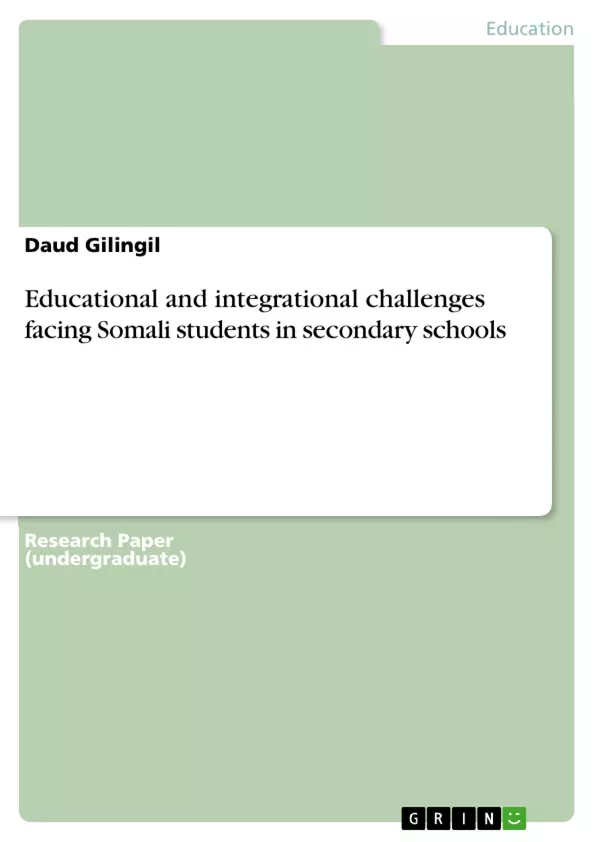This research examined the educational challenges faced Somali secondary students in North and South of Ireland, especially Dublin and Belfast areas, where there were a large number of Somali communities. It focused the current challenges they were facing in terms of the formal education system and social inclusion. The most of the students were born outside the state with little formal education, and their integrating into the system is a daunting task. Many joined school with an educational, deficit, unstable families, illiterate parents and poor family environment that is entirely dependent on social welfare.
The research tried to examine how these students overcame these educational barriers. The research looks at the parent’s role in improving their children’s educational performance. It also highlighted the enormous challenge and puzzling tasks many Somali student endure.
The study looked closely at the varieties of difficulties that they are facing in day to day life in schools such as lack of tutoring, mentoring and low self-esteem. It explored solutions to address these problems and the last, but not least recommends a resolution that will increase students’ performance. It also suggests significant steps to tackle Somali early school dropout.
Inhaltsverzeichnis (Table of Contents)
- Introduction and outline to the research:
- Introduction ...
- The History of Somali Refugee in Ireland.
- Post war education in Somalia...........
- Somali children denied universal human rights
- Problems Assessment integrating in the local system.
- Rationale of Research
- Conclusion
- The Research Objectives.......
- The purpose of the research..\n
- Research Question.
- Constraint of the research......
- A Review of Literature
- Introduction....
- Language and communication barriers........
- Conclusion.......
- Cultural Shock
- Challenges of Parents Illiteracy
- Accommodation family size and home environment...
- Single Mothers and students relationship ......
- Bullying and Racism at Schools........
- Low income families and its impact on students
- Khat and education Impact
- Somali immigrant integration and education
- The Lack of Unity among Somali Community and the lack of role\nmodel
- Conclusion
- Outline of research approach .....
- Introduction .....
- Methodology
- One to one in interview
- Unstructured interview
- Focus group.....
- Main Informants........
- Students with less than two years in the country
- Students in the country more than two years .......
- Students born in Ireland.
- Why we chose community leaders..\n
- Parents..........\n
- Students' Parents .......\n
- Single mothers .........\n
- Ethics
- Problems that arose for data collection
- Problem I encountered for data collection and the way I solve it.....
- The Background and experience of the participates
- Presentation of research finds………………………..\n
- Interview structural and unstructured.\n
- Questionnaire .........\n
- Focus Group
- Educational barriers: finding from the data
- Students in less than two year in the country........
- Accommodation and Family Size are part of educational barrier...........
- Islamic School and Time Constrain on students ...........\n
- Bullying and racism impact on students self confidence..\n
- Students Lack of Integration and education\n
- Remittance is burden on students ........
- Low income families and educational impacts
- Parents Literacy is obstacle for students learning ….....\n
- Communication gap between Parent and secondary school.
- Single Mothers and education barriers at schools
- Parent Khat Users and Education impact on students.\n
- Curriculum is a complicated system on Somali secondary\nstudents.........
- The lack of agreement among Somali community
- Analysis of Findings
- Introduction.
- Education integration challenges......
- Limited Proficient English.......
- Parents with low education background impact on students'\nperformance....
- Lack of Integration and educational challenges
- Low Income Family influence on students' performance
- Khat Influence on Students Education
- The imperative of data collection .....
- Conclusions .......
- Recommendations and Conclusions.
- Introduction..\n
- Recommendation.......
- Somali Students.
- Somali Parents..\n
- Somali Community
- Conclusion....
Zielsetzung und Themenschwerpunkte (Objectives and Key Themes)
The research investigates the educational and integration challenges encountered by Somali students in Ireland's secondary school system, exploring the multifaceted factors impacting their academic experience. It aims to analyze these obstacles and identify potential solutions.
- Educational and integration challenges faced by Somali students
- Impact of socio-economic factors on Somali students' education
- Influence of cultural and language barriers on integration
- Role of parents and the Somali community in supporting students
- Recommendations for improving the educational experience of Somali students
Zusammenfassung der Kapitel (Chapter Summaries)
The introduction outlines the research's scope, background, and objectives. It delves into the history of Somali refugees in Ireland and explores the unique educational challenges faced by Somali children in the post-war context. Chapter 2 examines a wide range of obstacles faced by Somali students, including language and communication barriers, cultural shock, parental illiteracy, accommodation and family size issues, single-parent households, bullying, racism, low-income families, khat use, and the lack of community unity. Chapter 3 details the research methodology, highlighting the use of individual interviews, focus groups, and questionnaires. Chapter 4 presents the findings, analyzing the specific educational barriers identified through the data collection process.
Schlüsselwörter (Keywords)
The core themes and concepts explored in the research include: Somali refugee integration, educational challenges, language barriers, cultural adaptation, socio-economic factors, parental involvement, community support, and recommendations for improving the educational experience of Somali students.
- Quote paper
- Daud Gilingil (Author), 2013, Educational and integrational challenges facing Somali students in secondary schools, Munich, GRIN Verlag, https://www.grin.com/document/277541



